General Motors (GM) Market Analysis: An Economic Report and Analysis
VerifiedAdded on 2023/01/07
|11
|3048
|26
Report
AI Summary
This report provides a comprehensive market analysis of General Motors (GM), focusing on its role in the automotive industry. It begins with an introduction to management concepts and their application to complex market challenges. The main body of the report includes a detailed description of GM, its historical background, and global operations. A thorough market analysis of GM is presented, including its product offerings, target markets, and financial performance from 2017 to 2019. The report then examines the market structure of GM, identifying it as an oligopoly and discussing its characteristics and implications. The analysis considers the nature of the industry, discussing different market structures and the potential impact of government intervention. The report concludes with key recommendations regarding the automotive sector's development, considering both social gains and the role of government action.

Economics
Paraphrase This Document
Need a fresh take? Get an instant paraphrase of this document with our AI Paraphraser
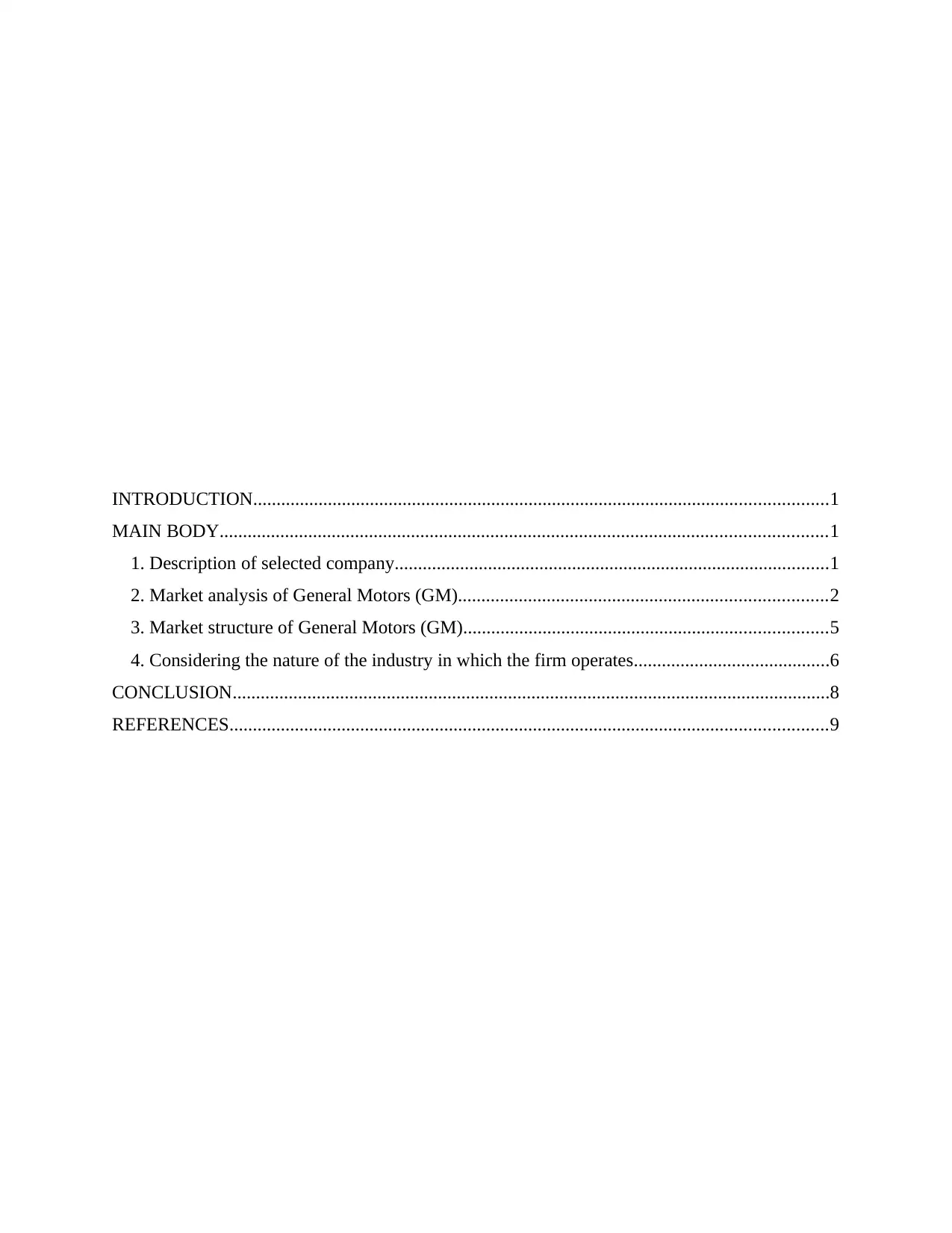
INTRODUCTION...........................................................................................................................1
MAIN BODY..................................................................................................................................1
1. Description of selected company.............................................................................................1
2. Market analysis of General Motors (GM)...............................................................................2
3. Market structure of General Motors (GM)..............................................................................5
4. Considering the nature of the industry in which the firm operates..........................................6
CONCLUSION................................................................................................................................8
REFERENCES................................................................................................................................9
MAIN BODY..................................................................................................................................1
1. Description of selected company.............................................................................................1
2. Market analysis of General Motors (GM)...............................................................................2
3. Market structure of General Motors (GM)..............................................................................5
4. Considering the nature of the industry in which the firm operates..........................................6
CONCLUSION................................................................................................................................8
REFERENCES................................................................................................................................9
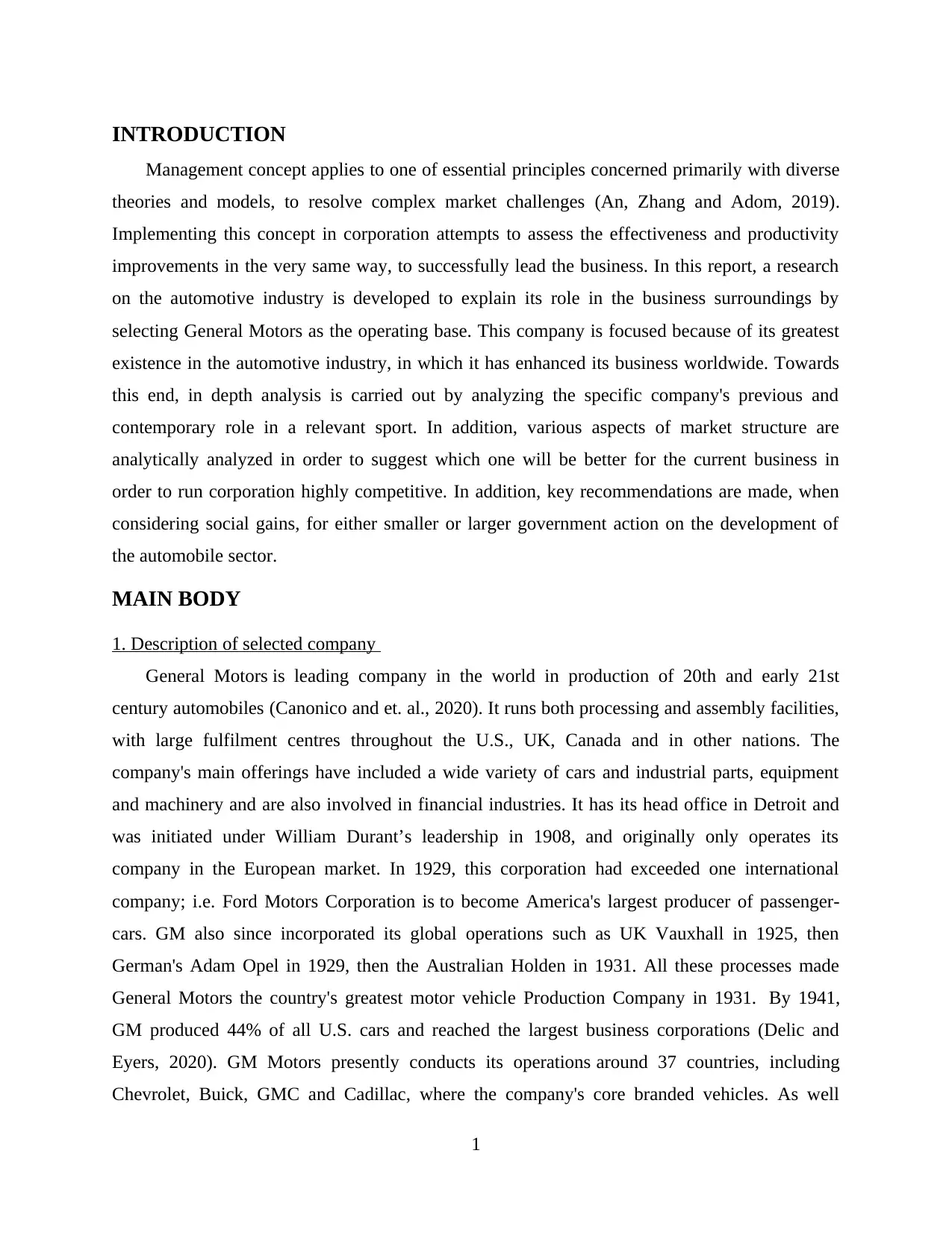
INTRODUCTION
Management concept applies to one of essential principles concerned primarily with diverse
theories and models, to resolve complex market challenges (An, Zhang and Adom, 2019).
Implementing this concept in corporation attempts to assess the effectiveness and productivity
improvements in the very same way, to successfully lead the business. In this report, a research
on the automotive industry is developed to explain its role in the business surroundings by
selecting General Motors as the operating base. This company is focused because of its greatest
existence in the automotive industry, in which it has enhanced its business worldwide. Towards
this end, in depth analysis is carried out by analyzing the specific company's previous and
contemporary role in a relevant sport. In addition, various aspects of market structure are
analytically analyzed in order to suggest which one will be better for the current business in
order to run corporation highly competitive. In addition, key recommendations are made, when
considering social gains, for either smaller or larger government action on the development of
the automobile sector.
MAIN BODY
1. Description of selected company
General Motors is leading company in the world in production of 20th and early 21st
century automobiles (Canonico and et. al., 2020). It runs both processing and assembly facilities,
with large fulfilment centres throughout the U.S., UK, Canada and in other nations. The
company's main offerings have included a wide variety of cars and industrial parts, equipment
and machinery and are also involved in financial industries. It has its head office in Detroit and
was initiated under William Durant’s leadership in 1908, and originally only operates its
company in the European market. In 1929, this corporation had exceeded one international
company; i.e. Ford Motors Corporation is to become America's largest producer of passenger-
cars. GM also since incorporated its global operations such as UK Vauxhall in 1925, then
German's Adam Opel in 1929, then the Australian Holden in 1931. All these processes made
General Motors the country's greatest motor vehicle Production Company in 1931. By 1941,
GM produced 44% of all U.S. cars and reached the largest business corporations (Delic and
Eyers, 2020). GM Motors presently conducts its operations around 37 countries, including
Chevrolet, Buick, GMC and Cadillac, where the company's core branded vehicles. As well
1
Management concept applies to one of essential principles concerned primarily with diverse
theories and models, to resolve complex market challenges (An, Zhang and Adom, 2019).
Implementing this concept in corporation attempts to assess the effectiveness and productivity
improvements in the very same way, to successfully lead the business. In this report, a research
on the automotive industry is developed to explain its role in the business surroundings by
selecting General Motors as the operating base. This company is focused because of its greatest
existence in the automotive industry, in which it has enhanced its business worldwide. Towards
this end, in depth analysis is carried out by analyzing the specific company's previous and
contemporary role in a relevant sport. In addition, various aspects of market structure are
analytically analyzed in order to suggest which one will be better for the current business in
order to run corporation highly competitive. In addition, key recommendations are made, when
considering social gains, for either smaller or larger government action on the development of
the automobile sector.
MAIN BODY
1. Description of selected company
General Motors is leading company in the world in production of 20th and early 21st
century automobiles (Canonico and et. al., 2020). It runs both processing and assembly facilities,
with large fulfilment centres throughout the U.S., UK, Canada and in other nations. The
company's main offerings have included a wide variety of cars and industrial parts, equipment
and machinery and are also involved in financial industries. It has its head office in Detroit and
was initiated under William Durant’s leadership in 1908, and originally only operates its
company in the European market. In 1929, this corporation had exceeded one international
company; i.e. Ford Motors Corporation is to become America's largest producer of passenger-
cars. GM also since incorporated its global operations such as UK Vauxhall in 1925, then
German's Adam Opel in 1929, then the Australian Holden in 1931. All these processes made
General Motors the country's greatest motor vehicle Production Company in 1931. By 1941,
GM produced 44% of all U.S. cars and reached the largest business corporations (Delic and
Eyers, 2020). GM Motors presently conducts its operations around 37 countries, including
Chevrolet, Buick, GMC and Cadillac, where the company's core branded vehicles. As well
1
⊘ This is a preview!⊘
Do you want full access?
Subscribe today to unlock all pages.

Trusted by 1+ million students worldwide
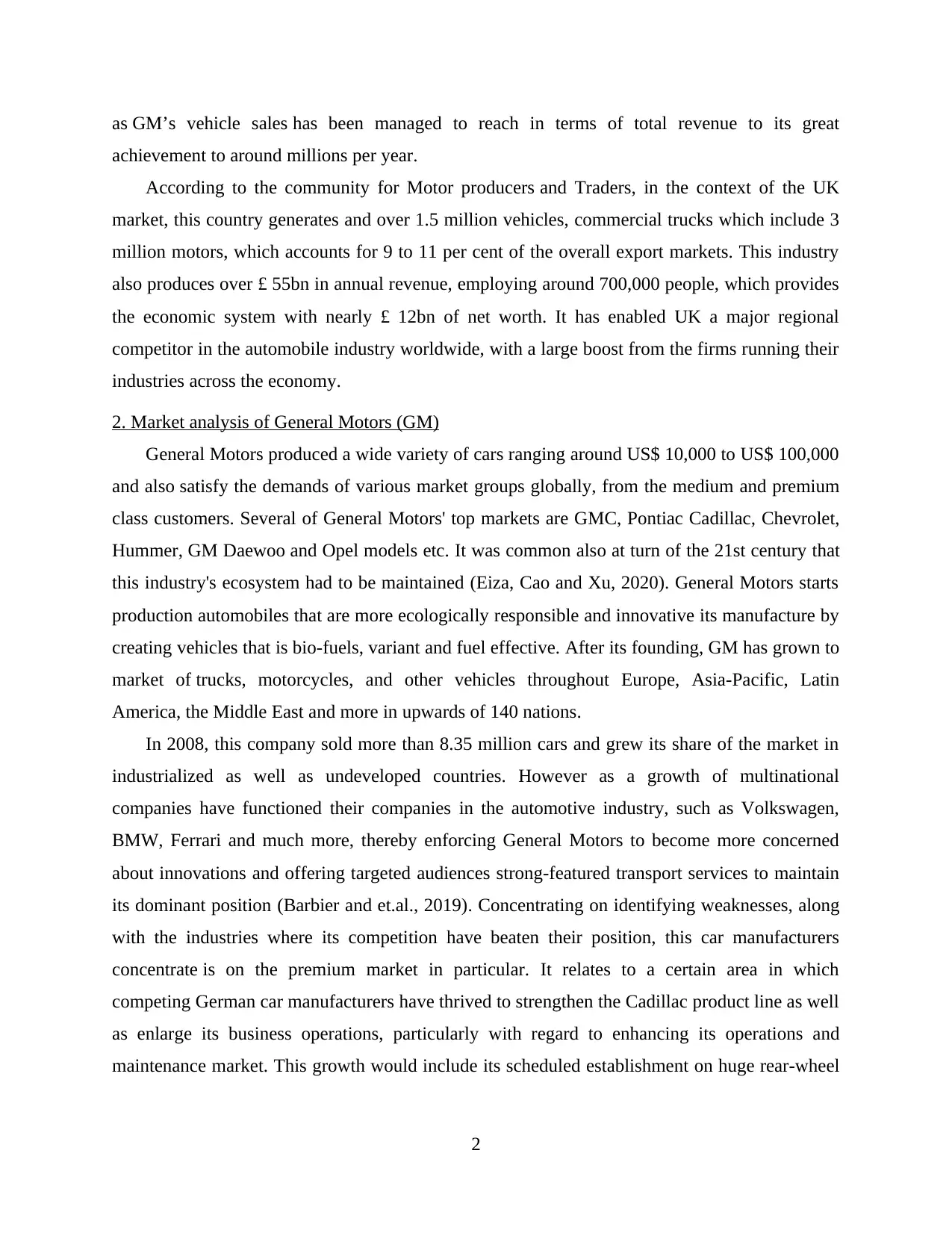
as GM’s vehicle sales has been managed to reach in terms of total revenue to its great
achievement to around millions per year.
According to the community for Motor producers and Traders, in the context of the UK
market, this country generates and over 1.5 million vehicles, commercial trucks which include 3
million motors, which accounts for 9 to 11 per cent of the overall export markets. This industry
also produces over £ 55bn in annual revenue, employing around 700,000 people, which provides
the economic system with nearly £ 12bn of net worth. It has enabled UK a major regional
competitor in the automobile industry worldwide, with a large boost from the firms running their
industries across the economy.
2. Market analysis of General Motors (GM)
General Motors produced a wide variety of cars ranging around US$ 10,000 to US$ 100,000
and also satisfy the demands of various market groups globally, from the medium and premium
class customers. Several of General Motors' top markets are GMC, Pontiac Cadillac, Chevrolet,
Hummer, GM Daewoo and Opel models etc. It was common also at turn of the 21st century that
this industry's ecosystem had to be maintained (Eiza, Cao and Xu, 2020). General Motors starts
production automobiles that are more ecologically responsible and innovative its manufacture by
creating vehicles that is bio-fuels, variant and fuel effective. After its founding, GM has grown to
market of trucks, motorcycles, and other vehicles throughout Europe, Asia-Pacific, Latin
America, the Middle East and more in upwards of 140 nations.
In 2008, this company sold more than 8.35 million cars and grew its share of the market in
industrialized as well as undeveloped countries. However as a growth of multinational
companies have functioned their companies in the automotive industry, such as Volkswagen,
BMW, Ferrari and much more, thereby enforcing General Motors to become more concerned
about innovations and offering targeted audiences strong-featured transport services to maintain
its dominant position (Barbier and et.al., 2019). Concentrating on identifying weaknesses, along
with the industries where its competition have beaten their position, this car manufacturers
concentrate is on the premium market in particular. It relates to a certain area in which
competing German car manufacturers have thrived to strengthen the Cadillac product line as well
as enlarge its business operations, particularly with regard to enhancing its operations and
maintenance market. This growth would include its scheduled establishment on huge rear-wheel
2
achievement to around millions per year.
According to the community for Motor producers and Traders, in the context of the UK
market, this country generates and over 1.5 million vehicles, commercial trucks which include 3
million motors, which accounts for 9 to 11 per cent of the overall export markets. This industry
also produces over £ 55bn in annual revenue, employing around 700,000 people, which provides
the economic system with nearly £ 12bn of net worth. It has enabled UK a major regional
competitor in the automobile industry worldwide, with a large boost from the firms running their
industries across the economy.
2. Market analysis of General Motors (GM)
General Motors produced a wide variety of cars ranging around US$ 10,000 to US$ 100,000
and also satisfy the demands of various market groups globally, from the medium and premium
class customers. Several of General Motors' top markets are GMC, Pontiac Cadillac, Chevrolet,
Hummer, GM Daewoo and Opel models etc. It was common also at turn of the 21st century that
this industry's ecosystem had to be maintained (Eiza, Cao and Xu, 2020). General Motors starts
production automobiles that are more ecologically responsible and innovative its manufacture by
creating vehicles that is bio-fuels, variant and fuel effective. After its founding, GM has grown to
market of trucks, motorcycles, and other vehicles throughout Europe, Asia-Pacific, Latin
America, the Middle East and more in upwards of 140 nations.
In 2008, this company sold more than 8.35 million cars and grew its share of the market in
industrialized as well as undeveloped countries. However as a growth of multinational
companies have functioned their companies in the automotive industry, such as Volkswagen,
BMW, Ferrari and much more, thereby enforcing General Motors to become more concerned
about innovations and offering targeted audiences strong-featured transport services to maintain
its dominant position (Barbier and et.al., 2019). Concentrating on identifying weaknesses, along
with the industries where its competition have beaten their position, this car manufacturers
concentrate is on the premium market in particular. It relates to a certain area in which
competing German car manufacturers have thrived to strengthen the Cadillac product line as well
as enlarge its business operations, particularly with regard to enhancing its operations and
maintenance market. This growth would include its scheduled establishment on huge rear-wheel
2
Paraphrase This Document
Need a fresh take? Get an instant paraphrase of this document with our AI Paraphraser
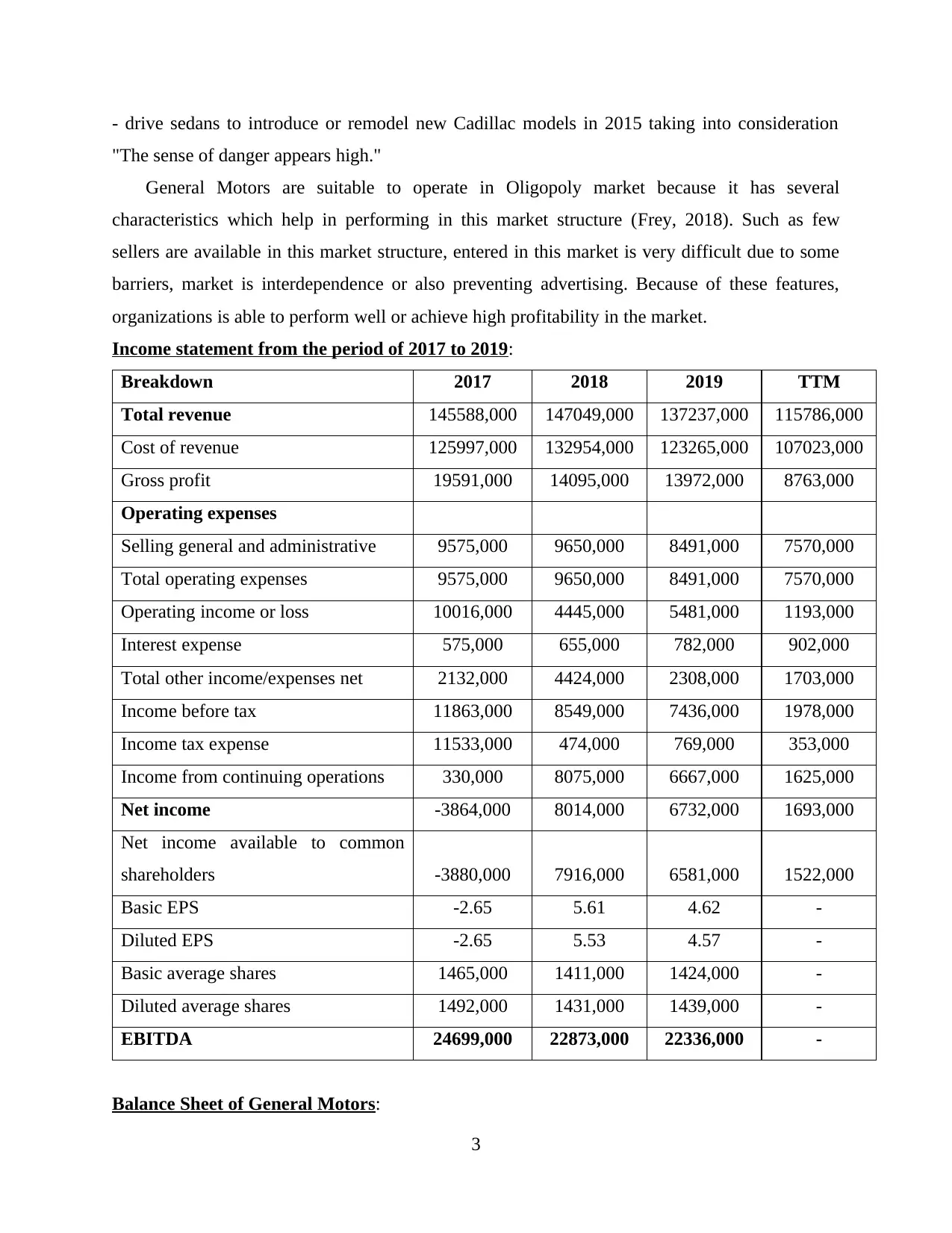
- drive sedans to introduce or remodel new Cadillac models in 2015 taking into consideration
"The sense of danger appears high."
General Motors are suitable to operate in Oligopoly market because it has several
characteristics which help in performing in this market structure (Frey, 2018). Such as few
sellers are available in this market structure, entered in this market is very difficult due to some
barriers, market is interdependence or also preventing advertising. Because of these features,
organizations is able to perform well or achieve high profitability in the market.
Income statement from the period of 2017 to 2019:
Breakdown 2017 2018 2019 TTM
Total revenue 145588,000 147049,000 137237,000 115786,000
Cost of revenue 125997,000 132954,000 123265,000 107023,000
Gross profit 19591,000 14095,000 13972,000 8763,000
Operating expenses
Selling general and administrative 9575,000 9650,000 8491,000 7570,000
Total operating expenses 9575,000 9650,000 8491,000 7570,000
Operating income or loss 10016,000 4445,000 5481,000 1193,000
Interest expense 575,000 655,000 782,000 902,000
Total other income/expenses net 2132,000 4424,000 2308,000 1703,000
Income before tax 11863,000 8549,000 7436,000 1978,000
Income tax expense 11533,000 474,000 769,000 353,000
Income from continuing operations 330,000 8075,000 6667,000 1625,000
Net income -3864,000 8014,000 6732,000 1693,000
Net income available to common
shareholders -3880,000 7916,000 6581,000 1522,000
Basic EPS -2.65 5.61 4.62 -
Diluted EPS -2.65 5.53 4.57 -
Basic average shares 1465,000 1411,000 1424,000 -
Diluted average shares 1492,000 1431,000 1439,000 -
EBITDA 24699,000 22873,000 22336,000 -
Balance Sheet of General Motors:
3
"The sense of danger appears high."
General Motors are suitable to operate in Oligopoly market because it has several
characteristics which help in performing in this market structure (Frey, 2018). Such as few
sellers are available in this market structure, entered in this market is very difficult due to some
barriers, market is interdependence or also preventing advertising. Because of these features,
organizations is able to perform well or achieve high profitability in the market.
Income statement from the period of 2017 to 2019:
Breakdown 2017 2018 2019 TTM
Total revenue 145588,000 147049,000 137237,000 115786,000
Cost of revenue 125997,000 132954,000 123265,000 107023,000
Gross profit 19591,000 14095,000 13972,000 8763,000
Operating expenses
Selling general and administrative 9575,000 9650,000 8491,000 7570,000
Total operating expenses 9575,000 9650,000 8491,000 7570,000
Operating income or loss 10016,000 4445,000 5481,000 1193,000
Interest expense 575,000 655,000 782,000 902,000
Total other income/expenses net 2132,000 4424,000 2308,000 1703,000
Income before tax 11863,000 8549,000 7436,000 1978,000
Income tax expense 11533,000 474,000 769,000 353,000
Income from continuing operations 330,000 8075,000 6667,000 1625,000
Net income -3864,000 8014,000 6732,000 1693,000
Net income available to common
shareholders -3880,000 7916,000 6581,000 1522,000
Basic EPS -2.65 5.61 4.62 -
Diluted EPS -2.65 5.53 4.57 -
Basic average shares 1465,000 1411,000 1424,000 -
Diluted average shares 1492,000 1431,000 1439,000 -
EBITDA 24699,000 22873,000 22336,000 -
Balance Sheet of General Motors:
3
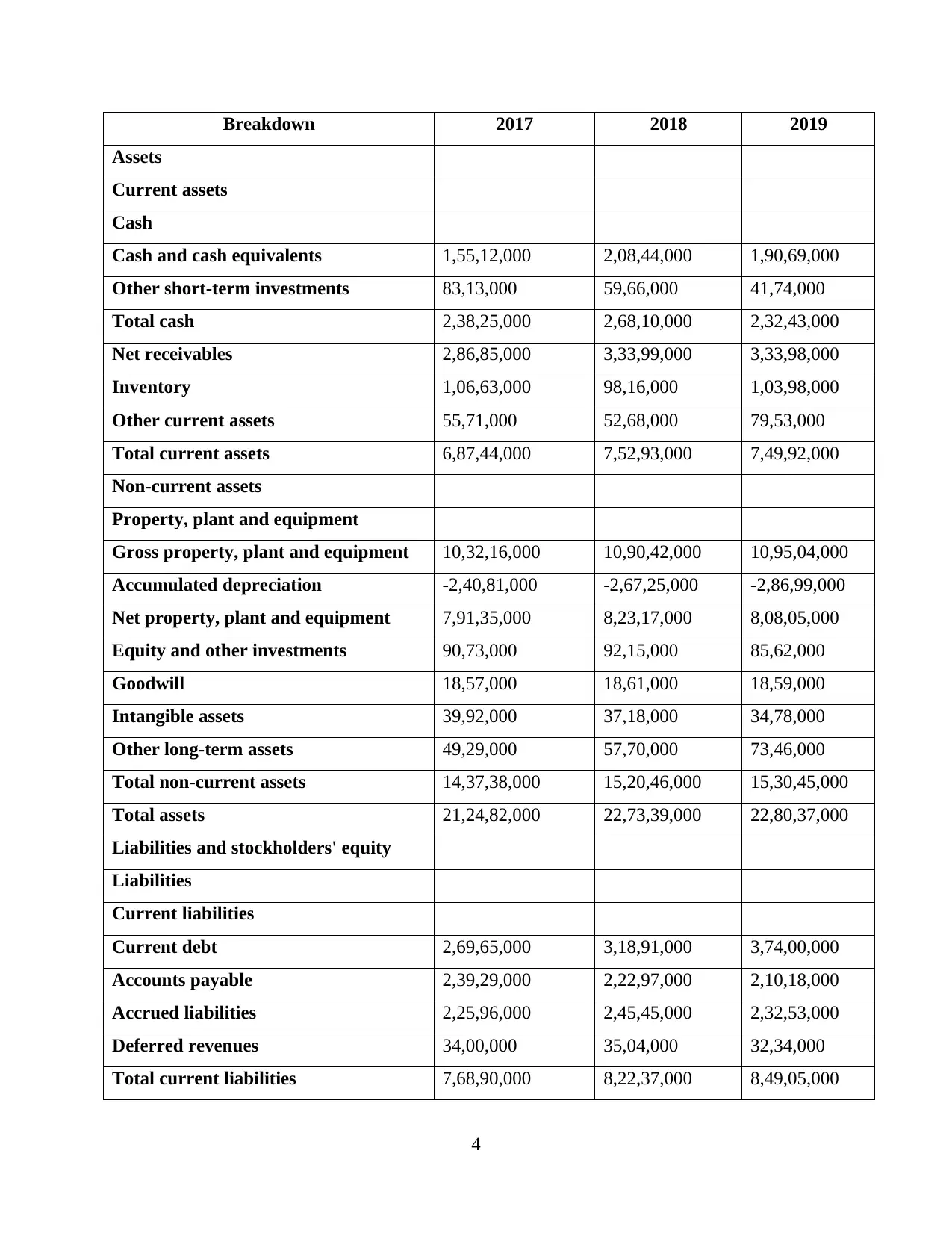
Breakdown 2017 2018 2019
Assets
Current assets
Cash
Cash and cash equivalents 1,55,12,000 2,08,44,000 1,90,69,000
Other short-term investments 83,13,000 59,66,000 41,74,000
Total cash 2,38,25,000 2,68,10,000 2,32,43,000
Net receivables 2,86,85,000 3,33,99,000 3,33,98,000
Inventory 1,06,63,000 98,16,000 1,03,98,000
Other current assets 55,71,000 52,68,000 79,53,000
Total current assets 6,87,44,000 7,52,93,000 7,49,92,000
Non-current assets
Property, plant and equipment
Gross property, plant and equipment 10,32,16,000 10,90,42,000 10,95,04,000
Accumulated depreciation -2,40,81,000 -2,67,25,000 -2,86,99,000
Net property, plant and equipment 7,91,35,000 8,23,17,000 8,08,05,000
Equity and other investments 90,73,000 92,15,000 85,62,000
Goodwill 18,57,000 18,61,000 18,59,000
Intangible assets 39,92,000 37,18,000 34,78,000
Other long-term assets 49,29,000 57,70,000 73,46,000
Total non-current assets 14,37,38,000 15,20,46,000 15,30,45,000
Total assets 21,24,82,000 22,73,39,000 22,80,37,000
Liabilities and stockholders' equity
Liabilities
Current liabilities
Current debt 2,69,65,000 3,18,91,000 3,74,00,000
Accounts payable 2,39,29,000 2,22,97,000 2,10,18,000
Accrued liabilities 2,25,96,000 2,45,45,000 2,32,53,000
Deferred revenues 34,00,000 35,04,000 32,34,000
Total current liabilities 7,68,90,000 8,22,37,000 8,49,05,000
4
Assets
Current assets
Cash
Cash and cash equivalents 1,55,12,000 2,08,44,000 1,90,69,000
Other short-term investments 83,13,000 59,66,000 41,74,000
Total cash 2,38,25,000 2,68,10,000 2,32,43,000
Net receivables 2,86,85,000 3,33,99,000 3,33,98,000
Inventory 1,06,63,000 98,16,000 1,03,98,000
Other current assets 55,71,000 52,68,000 79,53,000
Total current assets 6,87,44,000 7,52,93,000 7,49,92,000
Non-current assets
Property, plant and equipment
Gross property, plant and equipment 10,32,16,000 10,90,42,000 10,95,04,000
Accumulated depreciation -2,40,81,000 -2,67,25,000 -2,86,99,000
Net property, plant and equipment 7,91,35,000 8,23,17,000 8,08,05,000
Equity and other investments 90,73,000 92,15,000 85,62,000
Goodwill 18,57,000 18,61,000 18,59,000
Intangible assets 39,92,000 37,18,000 34,78,000
Other long-term assets 49,29,000 57,70,000 73,46,000
Total non-current assets 14,37,38,000 15,20,46,000 15,30,45,000
Total assets 21,24,82,000 22,73,39,000 22,80,37,000
Liabilities and stockholders' equity
Liabilities
Current liabilities
Current debt 2,69,65,000 3,18,91,000 3,74,00,000
Accounts payable 2,39,29,000 2,22,97,000 2,10,18,000
Accrued liabilities 2,25,96,000 2,45,45,000 2,32,53,000
Deferred revenues 34,00,000 35,04,000 32,34,000
Total current liabilities 7,68,90,000 8,22,37,000 8,49,05,000
4
⊘ This is a preview!⊘
Do you want full access?
Subscribe today to unlock all pages.

Trusted by 1+ million students worldwide
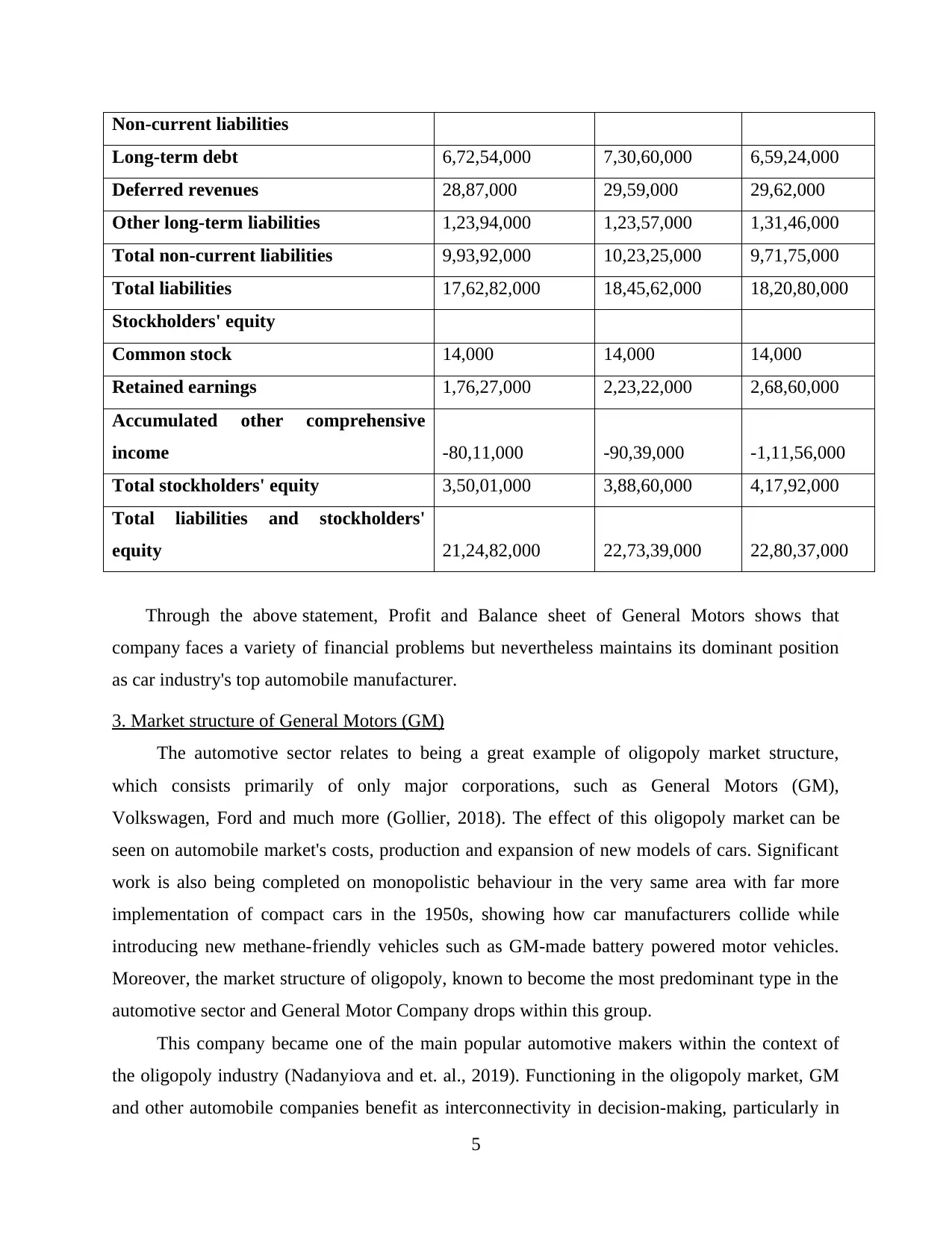
Non-current liabilities
Long-term debt 6,72,54,000 7,30,60,000 6,59,24,000
Deferred revenues 28,87,000 29,59,000 29,62,000
Other long-term liabilities 1,23,94,000 1,23,57,000 1,31,46,000
Total non-current liabilities 9,93,92,000 10,23,25,000 9,71,75,000
Total liabilities 17,62,82,000 18,45,62,000 18,20,80,000
Stockholders' equity
Common stock 14,000 14,000 14,000
Retained earnings 1,76,27,000 2,23,22,000 2,68,60,000
Accumulated other comprehensive
income -80,11,000 -90,39,000 -1,11,56,000
Total stockholders' equity 3,50,01,000 3,88,60,000 4,17,92,000
Total liabilities and stockholders'
equity 21,24,82,000 22,73,39,000 22,80,37,000
Through the above statement, Profit and Balance sheet of General Motors shows that
company faces a variety of financial problems but nevertheless maintains its dominant position
as car industry's top automobile manufacturer.
3. Market structure of General Motors (GM)
The automotive sector relates to being a great example of oligopoly market structure,
which consists primarily of only major corporations, such as General Motors (GM),
Volkswagen, Ford and much more (Gollier, 2018). The effect of this oligopoly market can be
seen on automobile market's costs, production and expansion of new models of cars. Significant
work is also being completed on monopolistic behaviour in the very same area with far more
implementation of compact cars in the 1950s, showing how car manufacturers collide while
introducing new methane-friendly vehicles such as GM-made battery powered motor vehicles.
Moreover, the market structure of oligopoly, known to become the most predominant type in the
automotive sector and General Motor Company drops within this group.
This company became one of the main popular automotive makers within the context of
the oligopoly industry (Nadanyiova and et. al., 2019). Functioning in the oligopoly market, GM
and other automobile companies benefit as interconnectivity in decision-making, particularly in
5
Long-term debt 6,72,54,000 7,30,60,000 6,59,24,000
Deferred revenues 28,87,000 29,59,000 29,62,000
Other long-term liabilities 1,23,94,000 1,23,57,000 1,31,46,000
Total non-current liabilities 9,93,92,000 10,23,25,000 9,71,75,000
Total liabilities 17,62,82,000 18,45,62,000 18,20,80,000
Stockholders' equity
Common stock 14,000 14,000 14,000
Retained earnings 1,76,27,000 2,23,22,000 2,68,60,000
Accumulated other comprehensive
income -80,11,000 -90,39,000 -1,11,56,000
Total stockholders' equity 3,50,01,000 3,88,60,000 4,17,92,000
Total liabilities and stockholders'
equity 21,24,82,000 22,73,39,000 22,80,37,000
Through the above statement, Profit and Balance sheet of General Motors shows that
company faces a variety of financial problems but nevertheless maintains its dominant position
as car industry's top automobile manufacturer.
3. Market structure of General Motors (GM)
The automotive sector relates to being a great example of oligopoly market structure,
which consists primarily of only major corporations, such as General Motors (GM),
Volkswagen, Ford and much more (Gollier, 2018). The effect of this oligopoly market can be
seen on automobile market's costs, production and expansion of new models of cars. Significant
work is also being completed on monopolistic behaviour in the very same area with far more
implementation of compact cars in the 1950s, showing how car manufacturers collide while
introducing new methane-friendly vehicles such as GM-made battery powered motor vehicles.
Moreover, the market structure of oligopoly, known to become the most predominant type in the
automotive sector and General Motor Company drops within this group.
This company became one of the main popular automotive makers within the context of
the oligopoly industry (Nadanyiova and et. al., 2019). Functioning in the oligopoly market, GM
and other automobile companies benefit as interconnectivity in decision-making, particularly in
5
Paraphrase This Document
Need a fresh take? Get an instant paraphrase of this document with our AI Paraphraser
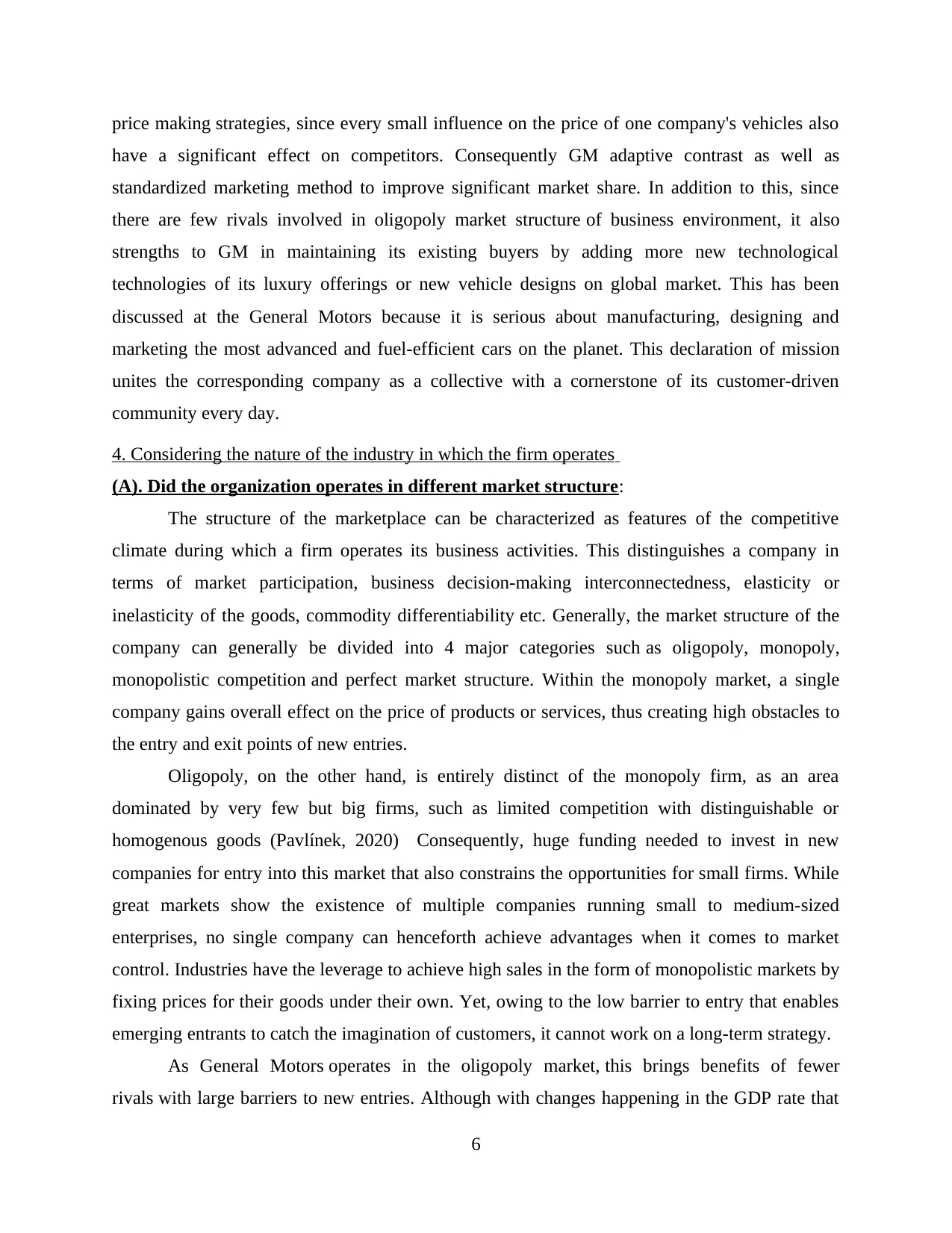
price making strategies, since every small influence on the price of one company's vehicles also
have a significant effect on competitors. Consequently GM adaptive contrast as well as
standardized marketing method to improve significant market share. In addition to this, since
there are few rivals involved in oligopoly market structure of business environment, it also
strengths to GM in maintaining its existing buyers by adding more new technological
technologies of its luxury offerings or new vehicle designs on global market. This has been
discussed at the General Motors because it is serious about manufacturing, designing and
marketing the most advanced and fuel-efficient cars on the planet. This declaration of mission
unites the corresponding company as a collective with a cornerstone of its customer-driven
community every day.
4. Considering the nature of the industry in which the firm operates
(A). Did the organization operates in different market structure:
The structure of the marketplace can be characterized as features of the competitive
climate during which a firm operates its business activities. This distinguishes a company in
terms of market participation, business decision-making interconnectedness, elasticity or
inelasticity of the goods, commodity differentiability etc. Generally, the market structure of the
company can generally be divided into 4 major categories such as oligopoly, monopoly,
monopolistic competition and perfect market structure. Within the monopoly market, a single
company gains overall effect on the price of products or services, thus creating high obstacles to
the entry and exit points of new entries.
Oligopoly, on the other hand, is entirely distinct of the monopoly firm, as an area
dominated by very few but big firms, such as limited competition with distinguishable or
homogenous goods (Pavlínek, 2020) Consequently, huge funding needed to invest in new
companies for entry into this market that also constrains the opportunities for small firms. While
great markets show the existence of multiple companies running small to medium-sized
enterprises, no single company can henceforth achieve advantages when it comes to market
control. Industries have the leverage to achieve high sales in the form of monopolistic markets by
fixing prices for their goods under their own. Yet, owing to the low barrier to entry that enables
emerging entrants to catch the imagination of customers, it cannot work on a long-term strategy.
As General Motors operates in the oligopoly market, this brings benefits of fewer
rivals with large barriers to new entries. Although with changes happening in the GDP rate that
6
have a significant effect on competitors. Consequently GM adaptive contrast as well as
standardized marketing method to improve significant market share. In addition to this, since
there are few rivals involved in oligopoly market structure of business environment, it also
strengths to GM in maintaining its existing buyers by adding more new technological
technologies of its luxury offerings or new vehicle designs on global market. This has been
discussed at the General Motors because it is serious about manufacturing, designing and
marketing the most advanced and fuel-efficient cars on the planet. This declaration of mission
unites the corresponding company as a collective with a cornerstone of its customer-driven
community every day.
4. Considering the nature of the industry in which the firm operates
(A). Did the organization operates in different market structure:
The structure of the marketplace can be characterized as features of the competitive
climate during which a firm operates its business activities. This distinguishes a company in
terms of market participation, business decision-making interconnectedness, elasticity or
inelasticity of the goods, commodity differentiability etc. Generally, the market structure of the
company can generally be divided into 4 major categories such as oligopoly, monopoly,
monopolistic competition and perfect market structure. Within the monopoly market, a single
company gains overall effect on the price of products or services, thus creating high obstacles to
the entry and exit points of new entries.
Oligopoly, on the other hand, is entirely distinct of the monopoly firm, as an area
dominated by very few but big firms, such as limited competition with distinguishable or
homogenous goods (Pavlínek, 2020) Consequently, huge funding needed to invest in new
companies for entry into this market that also constrains the opportunities for small firms. While
great markets show the existence of multiple companies running small to medium-sized
enterprises, no single company can henceforth achieve advantages when it comes to market
control. Industries have the leverage to achieve high sales in the form of monopolistic markets by
fixing prices for their goods under their own. Yet, owing to the low barrier to entry that enables
emerging entrants to catch the imagination of customers, it cannot work on a long-term strategy.
As General Motors operates in the oligopoly market, this brings benefits of fewer
rivals with large barriers to new entries. Although with changes happening in the GDP rate that
6
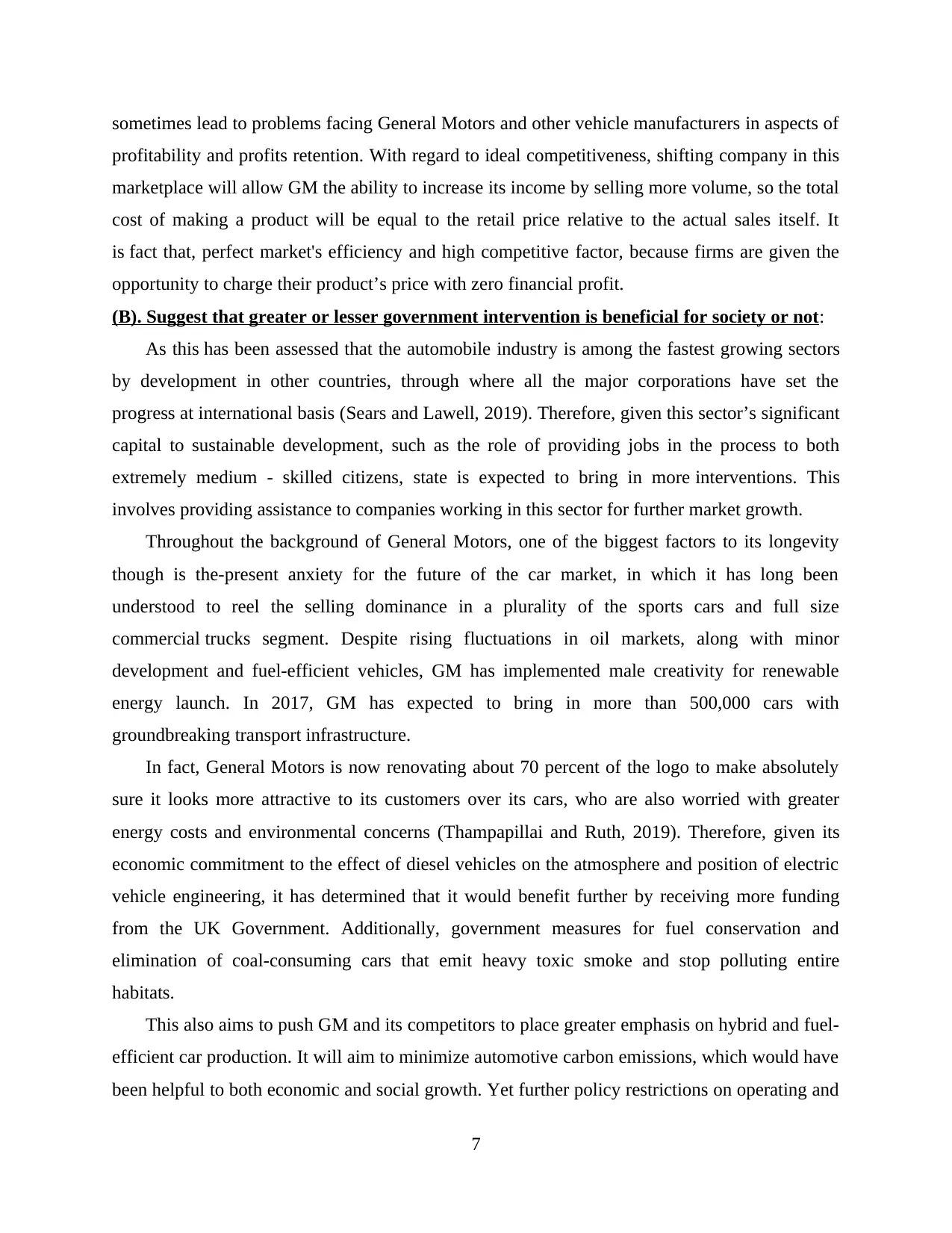
sometimes lead to problems facing General Motors and other vehicle manufacturers in aspects of
profitability and profits retention. With regard to ideal competitiveness, shifting company in this
marketplace will allow GM the ability to increase its income by selling more volume, so the total
cost of making a product will be equal to the retail price relative to the actual sales itself. It
is fact that, perfect market's efficiency and high competitive factor, because firms are given the
opportunity to charge their product’s price with zero financial profit.
(B). Suggest that greater or lesser government intervention is beneficial for society or not:
As this has been assessed that the automobile industry is among the fastest growing sectors
by development in other countries, through where all the major corporations have set the
progress at international basis (Sears and Lawell, 2019). Therefore, given this sector’s significant
capital to sustainable development, such as the role of providing jobs in the process to both
extremely medium - skilled citizens, state is expected to bring in more interventions. This
involves providing assistance to companies working in this sector for further market growth.
Throughout the background of General Motors, one of the biggest factors to its longevity
though is the-present anxiety for the future of the car market, in which it has long been
understood to reel the selling dominance in a plurality of the sports cars and full size
commercial trucks segment. Despite rising fluctuations in oil markets, along with minor
development and fuel-efficient vehicles, GM has implemented male creativity for renewable
energy launch. In 2017, GM has expected to bring in more than 500,000 cars with
groundbreaking transport infrastructure.
In fact, General Motors is now renovating about 70 percent of the logo to make absolutely
sure it looks more attractive to its customers over its cars, who are also worried with greater
energy costs and environmental concerns (Thampapillai and Ruth, 2019). Therefore, given its
economic commitment to the effect of diesel vehicles on the atmosphere and position of electric
vehicle engineering, it has determined that it would benefit further by receiving more funding
from the UK Government. Additionally, government measures for fuel conservation and
elimination of coal-consuming cars that emit heavy toxic smoke and stop polluting entire
habitats.
This also aims to push GM and its competitors to place greater emphasis on hybrid and fuel-
efficient car production. It will aim to minimize automotive carbon emissions, which would have
been helpful to both economic and social growth. Yet further policy restrictions on operating and
7
profitability and profits retention. With regard to ideal competitiveness, shifting company in this
marketplace will allow GM the ability to increase its income by selling more volume, so the total
cost of making a product will be equal to the retail price relative to the actual sales itself. It
is fact that, perfect market's efficiency and high competitive factor, because firms are given the
opportunity to charge their product’s price with zero financial profit.
(B). Suggest that greater or lesser government intervention is beneficial for society or not:
As this has been assessed that the automobile industry is among the fastest growing sectors
by development in other countries, through where all the major corporations have set the
progress at international basis (Sears and Lawell, 2019). Therefore, given this sector’s significant
capital to sustainable development, such as the role of providing jobs in the process to both
extremely medium - skilled citizens, state is expected to bring in more interventions. This
involves providing assistance to companies working in this sector for further market growth.
Throughout the background of General Motors, one of the biggest factors to its longevity
though is the-present anxiety for the future of the car market, in which it has long been
understood to reel the selling dominance in a plurality of the sports cars and full size
commercial trucks segment. Despite rising fluctuations in oil markets, along with minor
development and fuel-efficient vehicles, GM has implemented male creativity for renewable
energy launch. In 2017, GM has expected to bring in more than 500,000 cars with
groundbreaking transport infrastructure.
In fact, General Motors is now renovating about 70 percent of the logo to make absolutely
sure it looks more attractive to its customers over its cars, who are also worried with greater
energy costs and environmental concerns (Thampapillai and Ruth, 2019). Therefore, given its
economic commitment to the effect of diesel vehicles on the atmosphere and position of electric
vehicle engineering, it has determined that it would benefit further by receiving more funding
from the UK Government. Additionally, government measures for fuel conservation and
elimination of coal-consuming cars that emit heavy toxic smoke and stop polluting entire
habitats.
This also aims to push GM and its competitors to place greater emphasis on hybrid and fuel-
efficient car production. It will aim to minimize automotive carbon emissions, which would have
been helpful to both economic and social growth. Yet further policy restrictions on operating and
7
⊘ This is a preview!⊘
Do you want full access?
Subscribe today to unlock all pages.

Trusted by 1+ million students worldwide
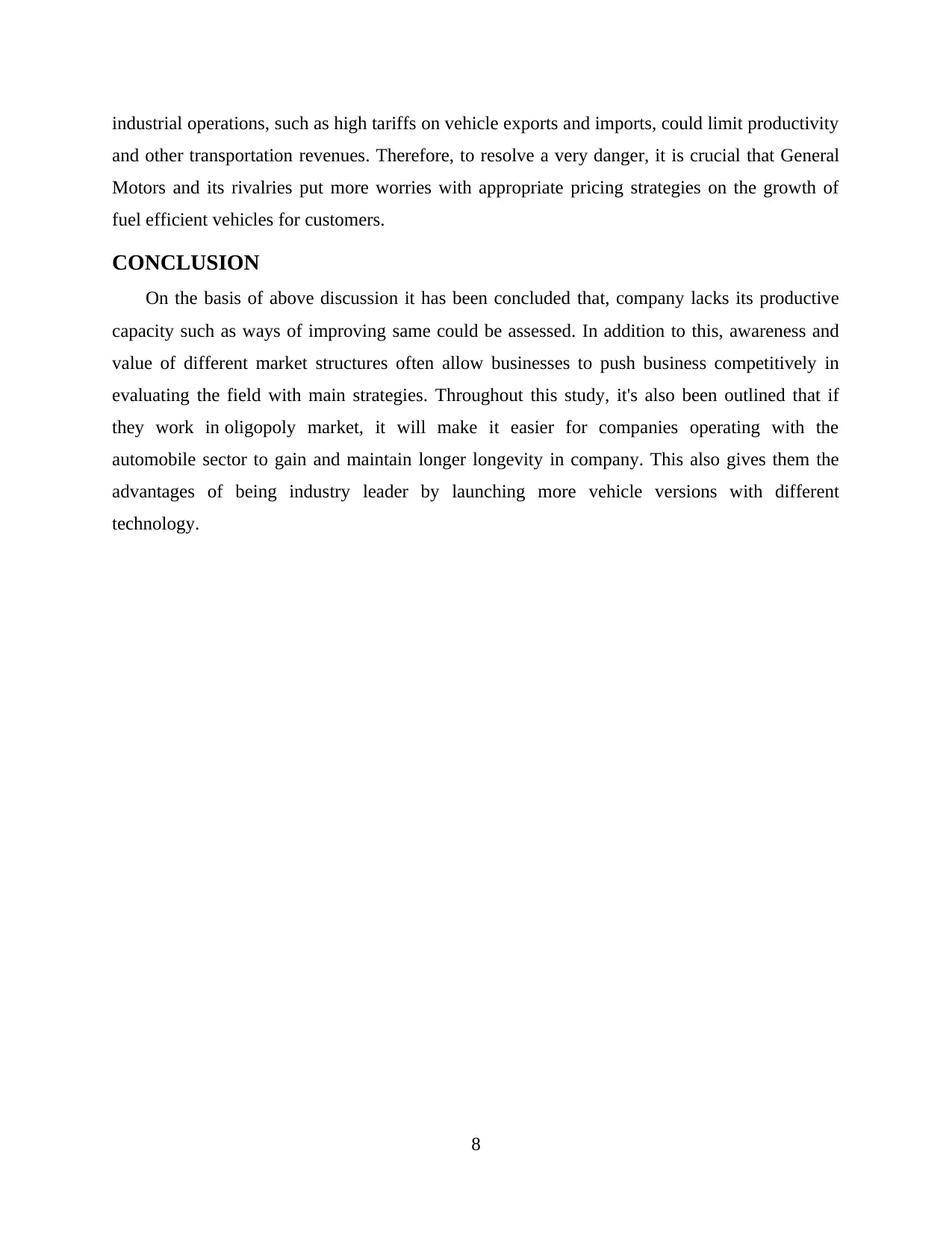
industrial operations, such as high tariffs on vehicle exports and imports, could limit productivity
and other transportation revenues. Therefore, to resolve a very danger, it is crucial that General
Motors and its rivalries put more worries with appropriate pricing strategies on the growth of
fuel efficient vehicles for customers.
CONCLUSION
On the basis of above discussion it has been concluded that, company lacks its productive
capacity such as ways of improving same could be assessed. In addition to this, awareness and
value of different market structures often allow businesses to push business competitively in
evaluating the field with main strategies. Throughout this study, it's also been outlined that if
they work in oligopoly market, it will make it easier for companies operating with the
automobile sector to gain and maintain longer longevity in company. This also gives them the
advantages of being industry leader by launching more vehicle versions with different
technology.
8
and other transportation revenues. Therefore, to resolve a very danger, it is crucial that General
Motors and its rivalries put more worries with appropriate pricing strategies on the growth of
fuel efficient vehicles for customers.
CONCLUSION
On the basis of above discussion it has been concluded that, company lacks its productive
capacity such as ways of improving same could be assessed. In addition to this, awareness and
value of different market structures often allow businesses to push business competitively in
evaluating the field with main strategies. Throughout this study, it's also been outlined that if
they work in oligopoly market, it will make it easier for companies operating with the
automobile sector to gain and maintain longer longevity in company. This also gives them the
advantages of being industry leader by launching more vehicle versions with different
technology.
8
Paraphrase This Document
Need a fresh take? Get an instant paraphrase of this document with our AI Paraphraser
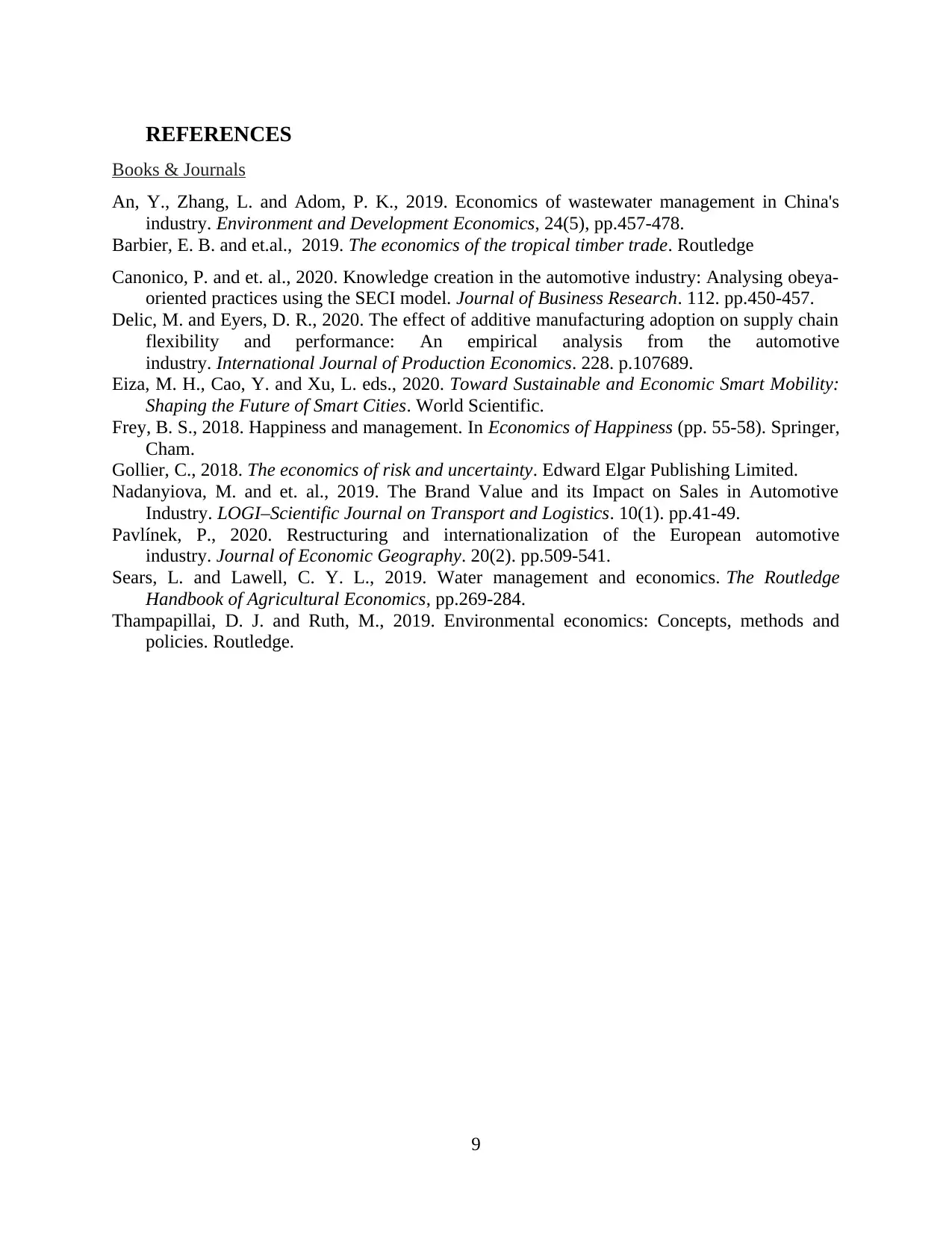
REFERENCES
Books & Journals
An, Y., Zhang, L. and Adom, P. K., 2019. Economics of wastewater management in China's
industry. Environment and Development Economics, 24(5), pp.457-478.
Barbier, E. B. and et.al., 2019. The economics of the tropical timber trade. Routledge
Canonico, P. and et. al., 2020. Knowledge creation in the automotive industry: Analysing obeya-
oriented practices using the SECI model. Journal of Business Research. 112. pp.450-457.
Delic, M. and Eyers, D. R., 2020. The effect of additive manufacturing adoption on supply chain
flexibility and performance: An empirical analysis from the automotive
industry. International Journal of Production Economics. 228. p.107689.
Eiza, M. H., Cao, Y. and Xu, L. eds., 2020. Toward Sustainable and Economic Smart Mobility:
Shaping the Future of Smart Cities. World Scientific.
Frey, B. S., 2018. Happiness and management. In Economics of Happiness (pp. 55-58). Springer,
Cham.
Gollier, C., 2018. The economics of risk and uncertainty. Edward Elgar Publishing Limited.
Nadanyiova, M. and et. al., 2019. The Brand Value and its Impact on Sales in Automotive
Industry. LOGI–Scientific Journal on Transport and Logistics. 10(1). pp.41-49.
Pavlínek, P., 2020. Restructuring and internationalization of the European automotive
industry. Journal of Economic Geography. 20(2). pp.509-541.
Sears, L. and Lawell, C. Y. L., 2019. Water management and economics. The Routledge
Handbook of Agricultural Economics, pp.269-284.
Thampapillai, D. J. and Ruth, M., 2019. Environmental economics: Concepts, methods and
policies. Routledge.
9
Books & Journals
An, Y., Zhang, L. and Adom, P. K., 2019. Economics of wastewater management in China's
industry. Environment and Development Economics, 24(5), pp.457-478.
Barbier, E. B. and et.al., 2019. The economics of the tropical timber trade. Routledge
Canonico, P. and et. al., 2020. Knowledge creation in the automotive industry: Analysing obeya-
oriented practices using the SECI model. Journal of Business Research. 112. pp.450-457.
Delic, M. and Eyers, D. R., 2020. The effect of additive manufacturing adoption on supply chain
flexibility and performance: An empirical analysis from the automotive
industry. International Journal of Production Economics. 228. p.107689.
Eiza, M. H., Cao, Y. and Xu, L. eds., 2020. Toward Sustainable and Economic Smart Mobility:
Shaping the Future of Smart Cities. World Scientific.
Frey, B. S., 2018. Happiness and management. In Economics of Happiness (pp. 55-58). Springer,
Cham.
Gollier, C., 2018. The economics of risk and uncertainty. Edward Elgar Publishing Limited.
Nadanyiova, M. and et. al., 2019. The Brand Value and its Impact on Sales in Automotive
Industry. LOGI–Scientific Journal on Transport and Logistics. 10(1). pp.41-49.
Pavlínek, P., 2020. Restructuring and internationalization of the European automotive
industry. Journal of Economic Geography. 20(2). pp.509-541.
Sears, L. and Lawell, C. Y. L., 2019. Water management and economics. The Routledge
Handbook of Agricultural Economics, pp.269-284.
Thampapillai, D. J. and Ruth, M., 2019. Environmental economics: Concepts, methods and
policies. Routledge.
9
1 out of 11
Related Documents
Your All-in-One AI-Powered Toolkit for Academic Success.
+13062052269
info@desklib.com
Available 24*7 on WhatsApp / Email
![[object Object]](/_next/static/media/star-bottom.7253800d.svg)
Unlock your academic potential
Copyright © 2020–2025 A2Z Services. All Rights Reserved. Developed and managed by ZUCOL.





